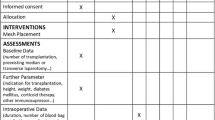Abstract
Background
Because of the lack of published data and the relative rarity of lateral incisional hernias (LIHs), especially after renal transplantation, mesh repair of LIH remains a challenge for surgeons. The aim of the present study was to evaluate the outcomes of LIH treated by mesh repair after renal transplantation.
Methods
All consecutive patients who had undergone LIH mesh repair after renal transplantation were compared with patients who had undergone LIH mesh repair without renal transplantation. Demographic data, incisional hernia characteristics, operative data, and postoperative outcomes were prospectively recorded. Early complications and recurrence rates were evaluated.
Results
Altogether, 112 patients were treated for LIH with mesh repair. Among these patients, 61 (54.4 %) underwent LIH after renal transplantation. The early complications were similar for the patients with and without renal transplantation (24.5 vs. 23.5 %, respectively; p = 0.896). The recurrence rates also were similar for the patients with and without renal transplantation (9.8 vs. 9.8 %, respectively; p = 1).
Conclusions
Mesh graft repair is feasible in patients with LIH after renal transplantation. Postoperative complications and recurrences were not more frequent in renal transplantation patients than in those without renal transplantation.
Similar content being viewed by others
References
Korenkov M, Paul A, Sauerland S et al (2001) Classification and surgical treatment of incisional hernia: results of an experts’ meeting. Langenbecks Arch Surg 386:65–73
Muysoms FE, Miserez M, Berrevoet F et al (2009) Classification of primary and incisional abdominal wall hernias. Hernia 13:407–414
Israelsson LA, Jonsson T (1996) Incisional hernia after midline laparotomy: a prospective study. Eur J Surg 162:125–129
Osther PJ, Gjode P, Mortensen BB et al (1995) Randomized comparison of polyglycolic acid and polyglyconate sutures for abdominal fascia closure after laparotomy in patients with suspected impaired wound healing. Br J Surg 82:1080–1082
Luijendijk RW, Hop WC, van den Tol MP et al (2000) A comparison of suture repair with mesh repair for incisional hernia. N Engl J Med 343:392–398
Halm JA, Lip H, Schmitz PI et al (2009) Incisional hernia after upper abdominal surgery: a randomised controlled trial of midline versus transverse incision. Hernia 13:275–280
Burger JW, van ‘t Riet M, Jeekel J (2002) Abdominal incisions: techniques and postoperative complications. Scand J Surg 91:315–321
Greenall MJ, Evans M, Pollock AV (1980) Midline or transverse laparotomy? A random controlled clinical trial. Part I. Influence on healing. Br J Surg 67:188–190
Kendall SW, Brennan TG, Guillou PJ (1991) Suture length to wound length ratio and the integrity of midline and lateral paramedian incisions. Br J Surg 78:705–707
Cassar K, Munro A (2002) Surgical treatment of incisional hernia. Br J Surg 89:534–545
Burger JW, Luijendijk RW, Hop WC et al (2004) Long-term follow-up of a randomized controlled trial of suture versus mesh repair of incisional hernia. Ann Surg 240:578–583
Sanjay P, Reid TD, Davies EL et al (2005) Retrospective comparison of mesh and sutured repair for adult umbilical hernias. Hernia 9:248–251
Veyrie N, Poghosyan T, Corigliano N et al (2013) Lateral incisional hernia repair by the retromuscular approach with polyester standard mesh: topographic considerations and long-term follow-up of 61 consecutive patients. World J Surg 37:538–544
Varga M, Matia I, Kucera M et al (2011) Polypropylene mesh repair of incisional hernia after kidney transplantation: single-center experience and review of the literature. Ann Transpl 16:121–125
Mazzucchi E, Nahas WC, Antonopoulos I et al (2001) Incisional hernia and its repair with polypropylene mesh in renal transplant recipients. J Urol 166:816–819
Li EN, Silverman RP, Goldberg NH (2005) Incisional hernia repair in renal transplantation patients. Hernia 9:231–237
Birolini C, Mazzucchi E, Utiyama EM et al (2001) Prosthetic repair of incisional hernia in kidney transplant patients: a technique with onlay polypropylene mesh. Hernia 5:31–35
Mahdavi R, Mehrabi M (2004) Incisional hernia after renal transplantation and its repair with propylene mesh. Urol J 1:259–262
Antonopoulos IM, Nahas WC, Mazzucchi E et al (2005) Is polypropylene mesh safe and effective for repairing infected incisional hernia in renal transplant recipients? Urology 66:874–877
Dindo D, Demartines N, Clavien PA (2004) Classification of surgical complications: a new proposal with evaluation in a cohort of 6336 patients and results of a survey. Ann Surg 240:205–213
Anthony T, Bergen PC, Kim LT et al (2000) Factors affecting recurrence following incisional herniorrhaphy. World J Surg 24:95–100. doi:10.1007/s002689910018
Jezupors A, Mihelsons M (2006) The analysis of infection after polypropylene mesh repair of abdominal wall hernia. World J Surg 30:2270–2278. doi:10.1007/s00268-006-0130-5
Foda M, Carlson MA (2009) Enterocutaneous fistula associated with ePTFE mesh: case report and review of the literature. Hernia 13:323–326
Gronnier C, Wattier JM, Favre H et al (2012) Risk factors for chronic pain after open ventral hernia repair by underlay mesh placement. World J Surg 36:1548–1554. doi:10.1007/s00268-012-1523-2
Den Hartog D, Dur AHM, Tuinebreijer WE et al (2008) Open surgical procedures for incisional hernia. Cochrane Database Sys Rev 16:006438
Gleysteen JJ (2009) Mesh-reinforced ventral hernia repair. Arch Surg 144:740–745
Stremitzer S, Bachleitner-Hofman T, Gradl B et al (2010) Mesh graft infection following abdominal hernia repair: risk factor evaluation and strategies of mesh graft preservation: a retrospective analysis of 476 operations. World J Surg 34:1702–1709. doi:10.1007/s00268-010-0543-z
Gurusamy KS, Allen VB (2013) Wound drains after incisional hernia repair. Cochrane Database Syst Rev 12:CD005570
Conflict of interest
None.
Author information
Authors and Affiliations
Corresponding author
Rights and permissions
About this article
Cite this article
Luc, G., David, A., Couzi, L. et al. Lateral Incisional Hernia After Renal Transplantation: A Comparative Study. World J Surg 38, 2791–2796 (2014). https://doi.org/10.1007/s00268-014-2689-6
Published:
Issue Date:
DOI: https://doi.org/10.1007/s00268-014-2689-6




